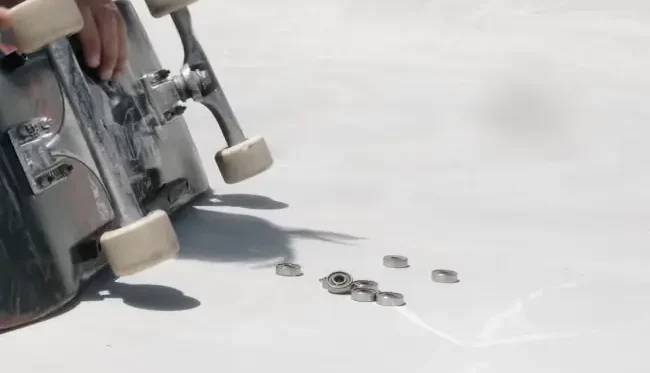The lifespan of skateboard bearings can actually vary quite a bit due to a few different factors. You know, things like how often you ride, the conditions you ride in, and how well you take care of your bearings can all play a role.
On average, though, if you’ve got decent quality bearings and you treat them right, they could last anywhere from a few months to a year, or maybe even more.
Speaking of taking care of them, there are some things you might want to keep in mind. If you’re out skating a lot, especially in wet or dirty places, that can really wear down your bearings faster.
Oh, and don’t forget about your riding style. How you ride can also impact how long your bearings last. If you’re doing a bunch of those high-impact moves, your bearings might wear out faster.
“At the end of the day, there’s no set rule for how long your skateboard bearings will hold up”. You’ll kind of get a feel for it over time.
Just keep an eye out for any changes in how they perform. If they start feeling slower, making more noise, or just not working as smoothly as they used to, it might be time to consider replacing them.
Some skaters like to swap them out more often to make sure their ride is always on point, while others might push them a bit further. It really depends on what you’re comfortable with and how much you want to keep your skateboard in top shape.
Here’s a detailed Infographics of the factors that affect how long skateboard bearings last:
The Essential Guide to Skateboard Bearing Longevity(The Detail Version):
Skateboarding isn’t just a sport; it’s a passion that takes us on exhilarating rides through streets and parks. At the heart of this experience are the skateboard bearings – those tiny components that ensure our wheels glide effortlessly. Ever wondered how long these little powerhouses can keep up with our skating adventures?
Let’s take a closer look at the factors that influence their lifespan and the human touch that keeps them spinning.
1. Usage Frequency:
Skating Intensity: If you skate every day or perform high-impact tricks, your bearings will wear out faster due to constant pressure and friction.
Casual vs. Hardcore Skating: Casual skaters who ride smoothly on flat surfaces will find that their bearings last longer, while more aggressive skaters will experience quicker wear and tear.
2. Terrain:
Smooth Surfaces (Skateparks, Pavements): Bearings tend to last longer when you ride on smooth surfaces as there is less stress on the wheels and bearings.
Rough Surfaces (Streets, Gravel, Dirt): Rougher terrains put more strain on the bearings, causing them to wear out faster. Dirt and debris can also get into the bearings, making them less efficient and leading to quicker damage.
Wet or Muddy Terrain: Riding in wet conditions is particularly harmful, as water can rust or corrode the metal components in the bearings, drastically shortening their lifespan.
3. Maintenance and Care:
Cleaning: Bearings accumulate dust, dirt, and debris over time. If they’re not cleaned regularly, this buildup can cause friction, reducing the lifespan of the bearings. Skaters who regularly clean their bearings will see them last longer.
Lubrication: Bearings need to be lubricated to minimize friction between the balls and the inner casing. Without proper lubrication, the increased friction will cause them to degrade faster. Regular lubrication prevents overheating and keeps them running smoothly.
Replacing Shields/Seals: The rubber or metal shields that protect the bearings can wear down over time. Keeping these clean and replacing them when needed helps prevent dirt from entering the bearing, which could extend the life of the bearing.
4. Skating Style:
Tricks and Jumps: Skaters who frequently perform tricks like ollies, grinds, or flips place more impact and stress on their bearings, wearing them out more quickly.
Speed: Higher speeds create more friction and heat in the bearings, which can lead to faster degradation. Speed-focused skaters (like downhill riders) often need to replace their bearings more frequently.
5. Weight of the Rider:
Heavier Riders: The more weight a bearing supports, the faster it can wear out. Heavier skaters typically experience shorter bearing life because of the increased load and pressure on the wheels and bearings.
6. Weather Conditions:
Rain and Moisture: Exposure to water or rain can rust bearings, which not only causes them to perform poorly but can also lead to long-term damage. Avoid riding in wet conditions or drying your bearings immediately afterward if they do get wet.
Cold or Hot Climates: Extremely cold conditions can cause bearings to stiffen up, while excessive heat can cause them to expand and possibly deform. Both can reduce the effectiveness of your bearings and shorten their lifespan.
7. Bearing Quality
Material Type: Bearings come in different materials like steel or ceramic. Ceramic bearings are more durable and resistant to rust but tend to be more expensive. Standard steel bearings are more common but can wear out faster, especially if exposed to moisture.
Brand and Construction: High-quality bearings from reputable brands tend to last longer because they are made with better materials and precision engineering.
8. Bearing Size and Type
Standard vs. Specialty Bearings: Most skateboard bearings are standardized (608 size), but some specialty bearings may offer more durability. However, these bearings may also require more maintenance or be harder to replace.
Sealed vs. Open Bearings: Sealed bearings are better at keeping out dirt and moisture but may have slightly more friction. Open bearings are easier to clean but more susceptible to dirt, which can reduce their lifespan if not properly maintained.
What is The Appropriate Time to Renew The Skateboard Bearings?
Wondering when it’s time to swap out those skateboard bearings? Generally, it’s a good idea to consider a replacement when you notice a decrease in smoothness during rides. If your board isn’t rolling as freely as before, or you hear a grinding sound, it might be time for some fresh bearings.
Why does Bearings maintenance matter?
Skateboard bearings are like the heartbeat of your ride – they make the wheels spin and keep you rolling forward. Maintaining these little powerhouses is crucial for a top-notch skate experience. Picture this: you’re carving down the street, wind in your hair, and suddenly, you feel that drag. That’s when you realise your bearings might need some love. Proper maintenance means cleaning out dirt and debris, and a touch of lubrication to keep them working their magic. It’s like giving your board a spa day to keep it performing at its best.
Think of your bearings like loyal companions on your skating journey. They’re always there, working quietly to make your ride smooth and enjoyable. Regular care ensures they don’t get worn out, which could affect your board’s performance. Just a bit of attention can save you from that annoying grinding sound or the feeling of resistance when you’re cruising. So, don’t forget to treat your bearings right – they’ll reward you with that familiar, effortless glide that makes skateboarding pure bliss.
Closing Remarks:
Skateboarding is all about freedom, thrill, and personal expression, but none of it feels quite right without smooth, reliable bearings keeping you in motion. While bearings may be small, their impact on your ride is huge. By understanding the factors that influence their lifespan and giving them the care they deserve, you can ensure that your skate sessions remain fast, fluid, and fun.
Whether you’re shredding at the skatepark, cruising the streets, or bombing hills, your bearings are your steadfast companions. So, take the time to clean, lubricate, and replace them when needed. A little effort goes a long way in maintaining the quality of your ride and extending the life of your gear.
Remember, skateboarding is a journey, and with the right attention to detail, your bearings will keep you rolling smoothly through every turn.

